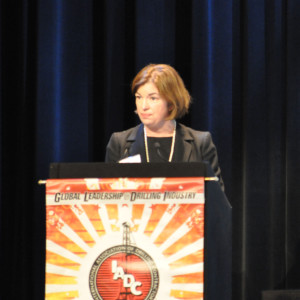Hess staying nimble on risk management during company transformation

By Joanne Liou, associate editor
Hess Corp is changing the way it manages risks, including non-technical risks, following an announcement in March to transform into a “pure play” company focusing on high-growth assets. “In Hess’ transformation, much change will be coming in the next months, and much of the best (of management principles) will remain the same,” Elizabeth “Libby” Cheney, Hess global vice president of environment, health, safety, and social responsibility, said. “The world is changing around us so quickly that we have to be nimble, and we have to be resilient. We have to build programs and organizations that can be flexible and change with the times,” she said in her keynote address at the 2013 IADC Environmental Conference in New York City on 8 April.
In light of the various social, safety, environmental and technical risks involved in today’s E&P, industry is redefining what it means to be nimble and resilient. “It’s a new sort of question and concept… the evolution or revolution we’re experiencing,” Ms Cheney stated, describing how Hess is transitioning “from little E to big E” when it comes to the environment. In the 1990s, environmental programs were characterized by reactions and were used to ensure compliance with regulations, she said. “Environmental services, considered the little E, were seen in those days as purely a cost center for the business.” However, in today’s world, compliance-based environmental management is not enough to gain an invitation to operate.
Hess’ environmental group is focused on learning from events across the industry and internally, using the knowledge gained to strengthen risk management. “Managing these risks is the key to creating and preserving long-term shareholder value,” which is at the core of transitioning to the big E, Ms Cheney noted. “The environmental stewardship and environmental risk management we developed over time will remain in place and continue to evolve.”
In one example of Hess’ efforts to manage risks, the company, with project partners Premiere Oil and Endeavour Energy, recently began a major deepsea decommissioning project in the UK involving 30 wells. “Just as we have to be careful managing the initiation of the project, we have to manage the departure,” Ms Cheney explained. “Regulatory guidance and the science around effective and complete decommissioning has led to the principle that we need to return the seabed to its original condition and do our best to ensure the stability of that condition.” Hess is maintaining a dialogue with a variety of stakeholders – UK governmental bodies, English and Scottish fishery organizations and other NGOs. “The team is taking extra safety precautions by stationing a vessel close to the operations to monitor potential interference from other sea traffic and to ensure the safety of our team.”
Material recovered from the operation – approximately 7,000 tons of steel and concrete – will be reused and recycled or responsibly disposed. Ms Cheney explained that the decommissioning effort is a leading example for three main reasons: 1) It aims to manage the major categories of risk – technical, financial, environmental, health, safety and social. 2) Communication and engagement among interested parties about the process, best practices and potential risks and solutions keep people informed and improve current practices to manage resources and risks. 3) Further, the team is continually improving those best practice standards across the globe so that every project can benefit from the knowledge and experience of colleagues. “This is a challenge; moving this information companywide, even in a small company like Hess, is something we have to work on everyday,” Ms Cheney noted.
The decommissioning effort is estimated cost approximately $550 million, and the company interprets the cost as an investment – “an investment to protect our company’s license to operate, our reputation and to protect our shareholders by reducing the risks of facing potential liabilities. It reflects the big E perspective.”




